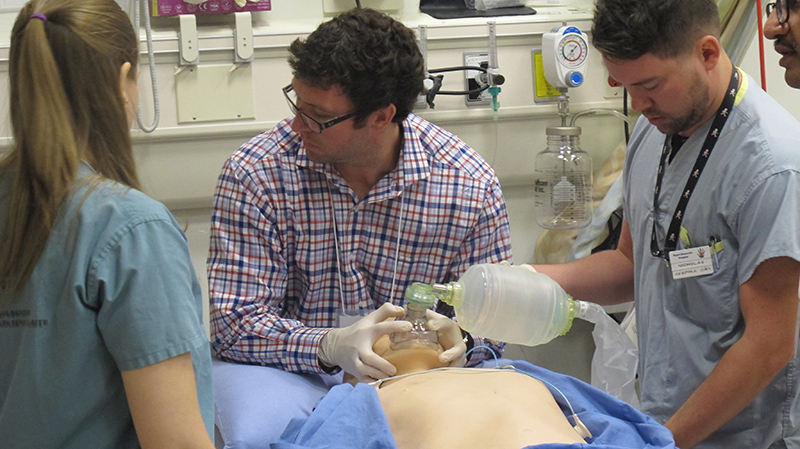
Critical care trainees undergo critical event simulation training in the University of Alberta's Health Sciences Education and Research Commons (HSERC).
One of Canada's largest annual simulation training events for health professionals is giving dozens of critical-care trainees from across the country important insight into handling real-life medical scenarios. Forty-four trainees, along with 27 nurses and respiratory therapists, are undertaking an intensive two-day multidisciplinary Acute Critical Events Simulation (ACES) training course at the University of Alberta's Health Sciences Education and Research Commons (HSERC).
"The real meat of the course is multidisciplinary simulations where, using mannequins, we simulate critical events," says Damian Paton-Gay, an intensive care physician, instructor with the Royal College of Physicians and Surgeons of Canada and a clinical assistant professor with the University of Alberta's Faculty of Medicine & Dentistry.
"In the course, teams of two trainees as well as two nurses and a respiratory therapist, manage a critical event in a simulated environment. The goal is to combine medical knowledge, technical skills and, most importantly, to assess and work on that team dynamic between providers."
The simulation training is an important step for the trainees as they work to become accredited intensive care doctors. About half of the time in the course will be spent on lectures and skill training, with the other half devoted to task-based simulations. The simulations will test the trainees in a variety of situations, from dealing with a patient suffering from an unknown major trauma, to helping a patient with severe pneumonia who is also suffering from other urgent critical health issues. They will also be tasked with inter-personal challenges, including conflict resolution within a highly charged environment.
Paton-Gay says the simulation training gives the trainees a unique opportunity.
"The classic way of learning this knowledge was on-the-job practice. We've learnt though that with computerized mannequins we have a great substitute for actual patients and we have a much better opportunity for trainees to practice realistically but also safely."
One of the first ACES courses was held in Edmonton 10 years ago. Since then it has been hosted by other institutions across the country and is only now making its return to the University of Alberta. Organizers are excited to showcase the U of A's simulation facilities.
"HSERC is an outstanding physical space and we hope to highlight some of its potential," says Neil Gibson, a clinical professor and director of simulation for the U of A's Faculty of Medicine & Dentistry. "Simulation training is becoming mandatory in the curricula for all health-care professionals, and we have the physical infrastructure to lead in this area. Our next step is to develop the local expertise, cooperation and volume that will take us there. This is clearly the way ahead in medical training."
Through the ACES training, Paton-Gay says the goal is to bring critical care trainees from variable backgrounds up to the same baseline level of knowledge before they move on to more complex aspects of intensive care.
"We are just fine with them making mistakes here. Our goal as faculty is to create a safe environment in which high-stakes events can be practiced with no risk to patients and to allow critical care trainees to go back to their home programs across Canada and focus on the fine details of critical care medicine. At the same time, our local critical care nurses and respiratory therapists benefit from training in the multidisciplinary setting with expert instructors."
The ACES course is being hosted with the cooperation of the University of Alberta, The Royal College of Physicians and Surgeons, and Alberta Health Services.